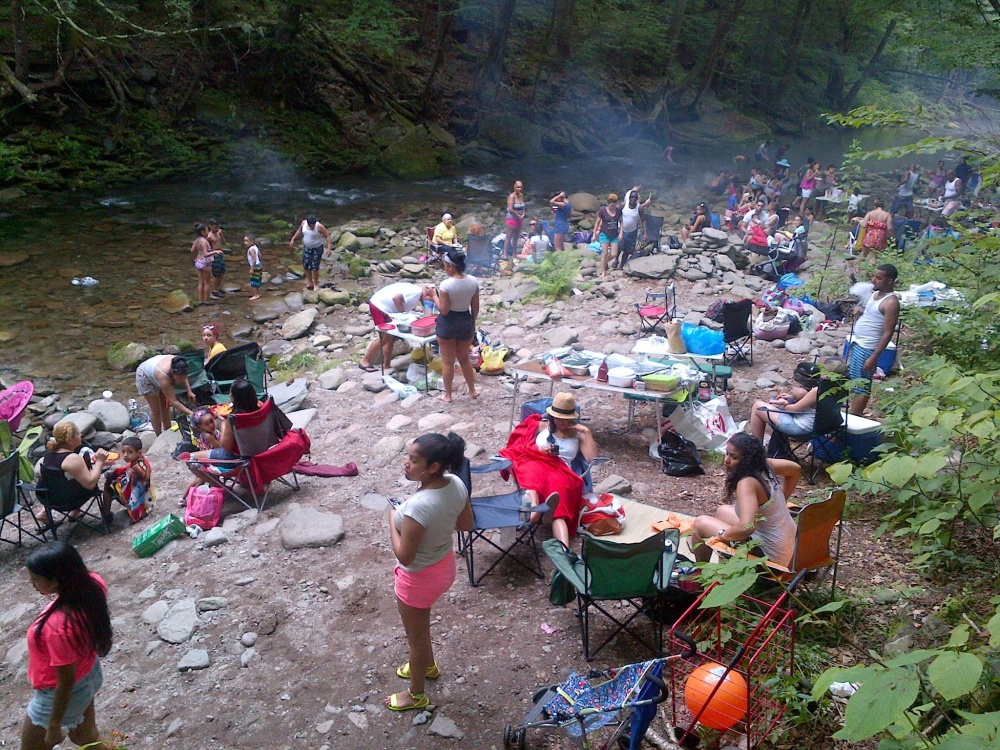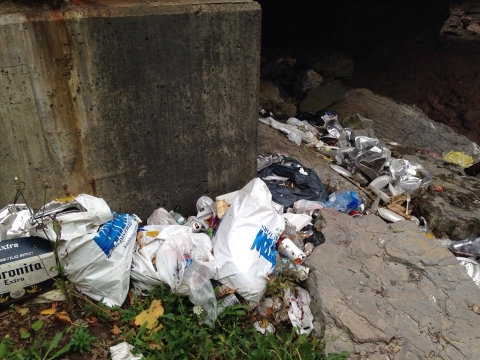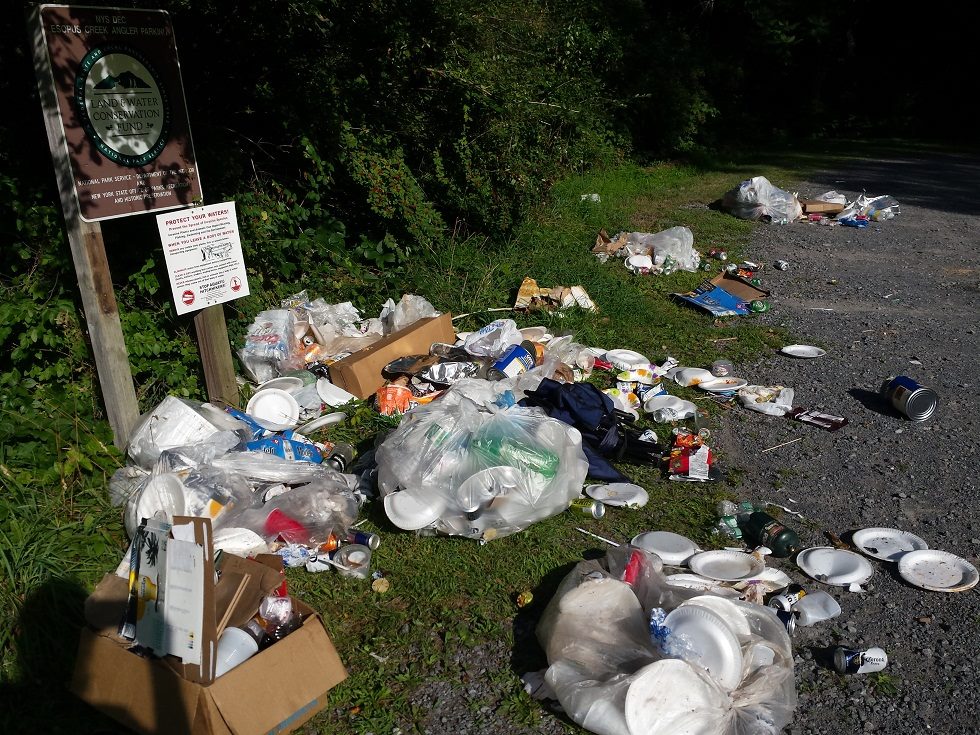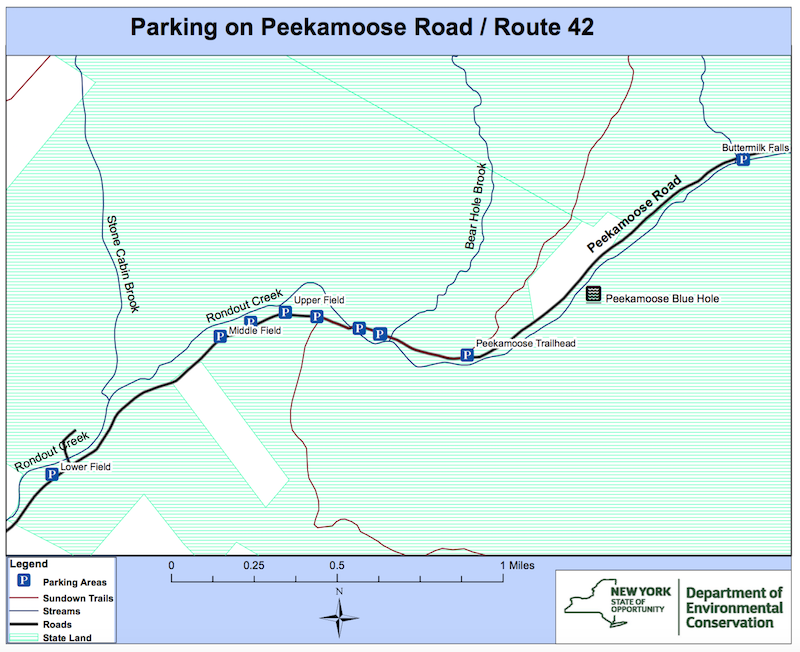Peggy Brueckner lives near the Peekamoose Blue Hole, an icy Catskills pool that is recognized as one of the best swimming holes in the country. Her family has visited the hidden spot for 50 years. But this summer, due to hordes of tourists and the tons of garbage they leave behind, Brueckner has been avoiding it.
"The locals here along Watson Hollow Road and beyond are heartbroken," Brueckner said. "There is litter all over the place. There are no laws being enforced and it a total mess up there. Campers are off the designated sites, people are in the middle of the road and it is a free for all! It's not even a family friendly place any more."

Above: Peekamoose Blue Hole on a recent summer day. Photo via the NYS DEC.
Forest rangers, nonprofit groups, locals and the tourists themselves say that trash in many outdoor hotspots in the Catskills has spiraled out of control, particularly at a swimming holes that have received a lot of press.
Peekamoose Blue Hole, a shimmering oasis on the Rondout Creek in the Peekamoose Valley portion of the Sundown Wild Forest in Ulster County, has been hit the hardest, officials say.
Apparently oblivious to the concepts of “leave no trace” and “carry in, carry out,” hundreds of visitors leave two or three truckloads of trash behind in the isolated spot every weekend, according to Wendy Rosenbach, a spokesperson for the New York State Department of Environmental Conservation, which oversees the area and is responsible for removing trash that is left there.
Above: A traffic barrier thrown from the road into the stream at Peekamoose Blue Hole. Photo by Edward Ostapczuk.
Things got so bad that in mid-August, the DEC installed a dumpster at Blue Hole, a location in the middle of isolated wilderness that doesn’t even have its own parking lot. Forest rangers patrol regularly, writing tickets, but they are simply overwhelmed by crowds of what observers say are hundreds of cars and people.
“It certainly appears to be worse than previous years,” Rosenbach said. “The amount of garbage left by visitors has far exceeded our ability to clean up after those who fail to carry out their garbage and dispose of it appropriately.”
Many blame the press. The Blue Hole has been featured on Travel + Leisure’s list of best American swimming holes, in I Love NY’s official tourism promo materials, on the cover of Visit Vortex’s Hudson Valley magazine and in our own list of swimming holes in the Catskills Outdoor Guide.
The burden of trash cleanup falls on DEC forest rangers and conservation officers, who are already stretched thin in the Catskills region. Volunteers have stepped in to help, but they, too, are overwhelmed.
“Diapers, condoms and beer”
“Trash has always been a problem in popular areas of the Catskills like Blue Hole or Kaaterskill Falls, but the increase in visitors over the last few years has led to increased amounts of trash,” said Doug Senterman, the Catskills program director for the New York-New Jersey Trail Conference, which organizes litter pick-up outings for volunteers in the region. The Trail Conference has a trash cleanup planned for Blue Hole this Labor Day, Sept. 7.
“While the Trail Conference stresses leave no trace hiking methods, we realize that many visitors are unfamiliar with good stewardship practices,” Senterman said.
That’s putting it nicely. Much of what’s being abandoned at swimming holes is intimate human waste, according to Heather Rolland, who, as the assistant program coordinator for the Trail Conference, led a group of volunteers in a litter pick-up event on July 5.
“Diapers, condoms and beer,” Rolland said. “That's what we picked up. Enormous amounts of all three.”
Swimmers leave behind underwear, too, as one photo taken in August by Gene Nicolato (top) shows.
On Tuesday, Sept. 1, the board of directors of the Ashokan Pepacton Watershed Chapter of Trout Unlimited sent a letter to the DEC asking that the state limit access to the swimming hole entirely.
“The increased garbage along the Rondout Creek is unsightly and a danger to users who enjoy this area while following rules and regulations,” wrote Edward Ostapczuk, an avid local fisherman who sits on the board. “Broken glass is on the increase; garbage left behind will only cause nuisance issues with wild animals. Plus, in high water flows this garbage will ultimately find its way to NYC’s Rondout Reservoir. This area is quickly gaining a reputation among caring users, who follow laws, as a place to now avoid.”
Other trouble spots
Blue Hole isn’t the only place in the Catskills being trashed.
“Large amounts of garbage” are left behind every week at the many waterfalls, swimming holes and parking lots that line the spectacular Kaaterskill Clove along Route 23A in Greene County, according to DEC spokesperson Rick Georgeson.
“The swimming holes along Kaaterskill Clove and Molly Smith parking lot are areas where people leave large amounts of garbage,” Georgeson said. “The ranger who patrols the area will often remove garbage from these areas on a weekly basis.”
Those rangers are getting fed up.
“With all the things I encounter with the public as a forest ranger, I have never understood why people cannot take out the items they bring in,” one Greene County forest ranger who was not named said in a statement issued by the DEC. “This carelessness ruins the natural beauty of our shared public forest lands.”

Above: Trash under Moore's Bridge on Route 23A on Sept. 21, 2014. Photo by Courtney Brower.
Local residents hate the growing litter problem in Kaaterskill Clove, too. A year ago, two Haines Falls sisters became so disgusted with the trash strewn along Route 23A that they spent a day picking up every piece of garbage they saw. The women, Colleen and Courtney Brower, filled 25 30-gallon trash bags in a few hours, and found debris everywhere: under bridges, along the road and in popular swimming spots.
Colgate Lake, a remote lake with primitive campsites in the Greene County town of Jewett, also has a trash problem, Georgeson said.
“Every year we have issues with garbage at Colgate Lake,” he said. “This year has been a bit better than other years, but there has been garbage left by user groups. Tickets have been issued for litter left at campsites and for unkempt sites.”
In the Greene County town of Durham, town officials completely shut down a popular and historic swimming hole on Catskill Creek in August after rowdy behavior by hordes of swimmers drew the ire of a new neighboring second home owner and the state Department of Health, according to the Daily Mail.
The Durham swimmers threw rocks, crammed dirty diapers into nearby mailboxes and left behind “hundreds of broken and empty beer bottles, cigarette butts and other trash” every weekend, the newspaper reported.
They were also caught on tape screaming and threatening a local property owner.
"I've been swimming here since I was five years old," one angry man can be heard yelling in one video, a comment that suggests that locals, along with tourists, are abusing outdoor spaces.

Above: Trash dumped at a fishing access point in Shandaken in August 2015. Photo by the Town of Shandaken.
In the Ulster County town of Shandaken, piles of deli containers, propane tanks, canned food, food, shoes, camp chairs, snack bags, beer cans and bottles showed up in the parking lot near a DEC fishing access parking lot near the Allaben Cemetery on Route 28, according to Shandaken Town Clerk Joyce Grant. The town sent its own maintenance man to the site to bag the garbage for the DEC conservation officer who later removed it. Grant believes that the trash was left by picnickers and visitors.
“To Shandaken Visitors: if you are going do leave a mess like this, just stay home!” Grant wrote in a Facebook post.
Local laws ignored
Leaving garbage in public areas of the Catskill Park is already prohibited, and a proposed law that would stiffen penalties for leaving garbage on state land is stalled in the state legislature.
But laws aren't always the biggest deterrent. There is no parking allowed next to Peekamoose Blue Hole, which is located on narrow two-lane Route 42 in the Ulster County town of Denning. (Visiting swimmers should use designated parking lots nearby, according to the DEC.) That message is obvious: there are “No Parking” signs, big orange traffic barriers and yellow hazard tape set up to block parking by the swimming hole.

Above: The only legal parking available on Route 42 near Peekamoose Blue Hole is at DEC parking areas, which are a third of a mile to a mile away. Source: NYS DEC.
Still, many visitors brazenly defy the rules. Cars lined Route 42 and sometimes completely blocked it this summer, according to Edward Ostapczuk, the Trout Unlimited board member.
“‘No Parking’ signs are being ignored, and in some cases torn out of the ground,” Ostapczuk wrote in the Trout Unlimited letter to the DEC this week. “The orange barrels have been thrown from UC 42 down into the Rondout Creek below. And the hazard tape is being ripped down … Some users aren’t just ignoring laws, they are flouting them.”
Above: A car parks in front of a "No Parking" sign at Peekamoose Blue Hole on Aug. 18. Photo by Edward Ostapczuk.
The parking situation in Kaaterskill Clove is just as bad, with drivers on Route 23A in Palenville ripping down “No Parking” signs and parking along private property to get access to swimming holes, according to the Daily Mail.
Catskills Trash Cleanup campaign
In partnership with Visit Vortex, the Catskill Center for Conservation and Development, the New York-New Jersey Trail Conference, the DEC and other organizations, we're starting a Catskills Trash Cleanup campaign.
Help us map #CatskillsTrash locations and get them cleaned up. Email a photo and its location to [email protected], or post a photo and its location with a #CatskillsTrash hashtag to Instagram, Facebook and Twitter. We’ll add it to our map of trash hotspots:
Above: Catskills trash hotspots from our Catskills trash map. Click on an icon to see a photo of trash that's been dumped in the Catskills. Add your photos of trash to the map! Email photo & location to [email protected]. Link to full-page map here.
Then: pick it up. Share tales and photos of yourself doing your bit to keep the Catskills cleaner than you found them with the #CatskillsTrash hashtag.
Other ways to help clean up Catskills trash:
1) Attend a volunteer clean-up day. The Catskill Conservation Corps and the New York-New Jersey Trail Conference are hosting a Blue Hole cleanup work day on Monday, Sept. 7 — Labor Day — from 2 p.m. to 5 p.m. Meet at the Olive Town Hall and park at 45 Watson Hollow Road, West Shokan, NY 12494 at 1:45 p.m. to get a ride -- that will keep parking issues at Blue Hole itself to a minimum.
2) "Leave no trace” and "carry in, carry out." “The public can be of help by carrying out what they carry in and disposing of their trash appropriately,” said DEC spokesperson Wendy Rosenbach. “This generally means bringing it home and disposing of it with their household garbage.”
3) Pick up extra trash on your own. “If the public wants to help out, they can pick up whatever trash they are comfortable with,” DEC spokesperson Rick Georgeson said. “The [rangers do] come across people who do this and it’s appreciated.”
4) Avoid high-traffic hotspots. There are many other places to swim in the Catskills that aren't being overused, Rosenbach said. The DEC recommends its North/South Lake Campground, Mongaup Pond Campground, Bear Spring Mt. Campground, and Little Pond Campground.














